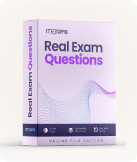Microsoft AZ-400 - Microsoft Azure DevOps Solutions Exam
Page: 1 / 113
Total 564 questions
Question #1 (Topic: Question Set 1)
You are configuring project metrics for dashboards in Azure DevOps.
You need to configure a chart widget that measures the elapsed time to complete work items once they become active.
Which of the following is the widget you should use?
You need to configure a chart widget that measures the elapsed time to complete work items once they become active.
Which of the following is the widget you should use?
A. Cumulative Flow Diagram
B. Burnup
C. Cycle time
D. Burndown
Answer: C
Question #2 (Topic: Question Set 1)
You need to consider the underlined segment to establish whether it is accurate.
The Burnup widget measures the elapsed time from creation of work items to their completion.
Select `No adjustment required` if the underlined segment is accurate. If the underlined segment is inaccurate, select the accurate option.
The Burnup widget measures the elapsed time from creation of work items to their completion.
Select `No adjustment required` if the underlined segment is accurate. If the underlined segment is inaccurate, select the accurate option.
A. No adjustment required.
B. Lead time
C. Test results trend
D. Burndown
Answer: B
Question #3 (Topic: Question Set 1)
You are making use of Azure DevOps manage build pipelines, and also deploy pipelines.
The development team is quite large, and is regularly added to.
You have been informed that the management of users and licenses must be automated when it can be.
Which of the following is a task that can't be automated?
The development team is quite large, and is regularly added to.
You have been informed that the management of users and licenses must be automated when it can be.
Which of the following is a task that can't be automated?
A. Group membership changes
B. License assignment
C. Assigning entitlements
D. License procurement
Answer: D
Question #4 (Topic: Question Set 1)
You have been tasked with strengthening the security of your team's development process.
You need to suggest a security tool type for the Continuous Integration (CI) phase of the development process.
Which of the following is the option you would suggest?
You need to suggest a security tool type for the Continuous Integration (CI) phase of the development process.
Which of the following is the option you would suggest?
A. Penetration testing
B. Static code analysis
C. Threat modeling
D. Dynamic code analysis
Answer: B
Question #5 (Topic: Question Set 1)
Your company is currently making use of Team Foundation Server 2013 (TFS 2013), but intend to migrate to Azure DevOps.
You have been tasked with supplying a migration approach that allows for the preservation of Team Foundation Version Control changesets dates, as well as the
changes dates of work items revisions. The approach should also allow for the migration of all TFS artifacts, while keeping migration effort to a minimum.
You have suggested upgrading TFS to the most recent RTW release.
Which of the following should also be suggested?
You have been tasked with supplying a migration approach that allows for the preservation of Team Foundation Version Control changesets dates, as well as the
changes dates of work items revisions. The approach should also allow for the migration of all TFS artifacts, while keeping migration effort to a minimum.
You have suggested upgrading TFS to the most recent RTW release.
Which of the following should also be suggested?
A. Installing the TFS kava SDK
B. Using the TFS Database Import Service to perform the upgrade.
C. Upgrading PowerShell Core to the latest version.
D. Using the TFS Integration Platform to perform the upgrade.
Answer: B
